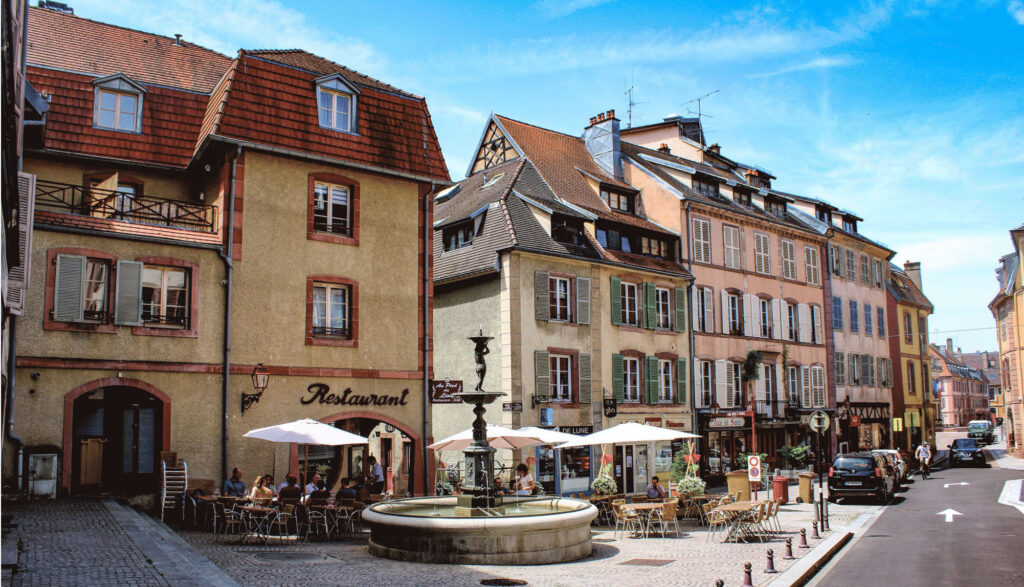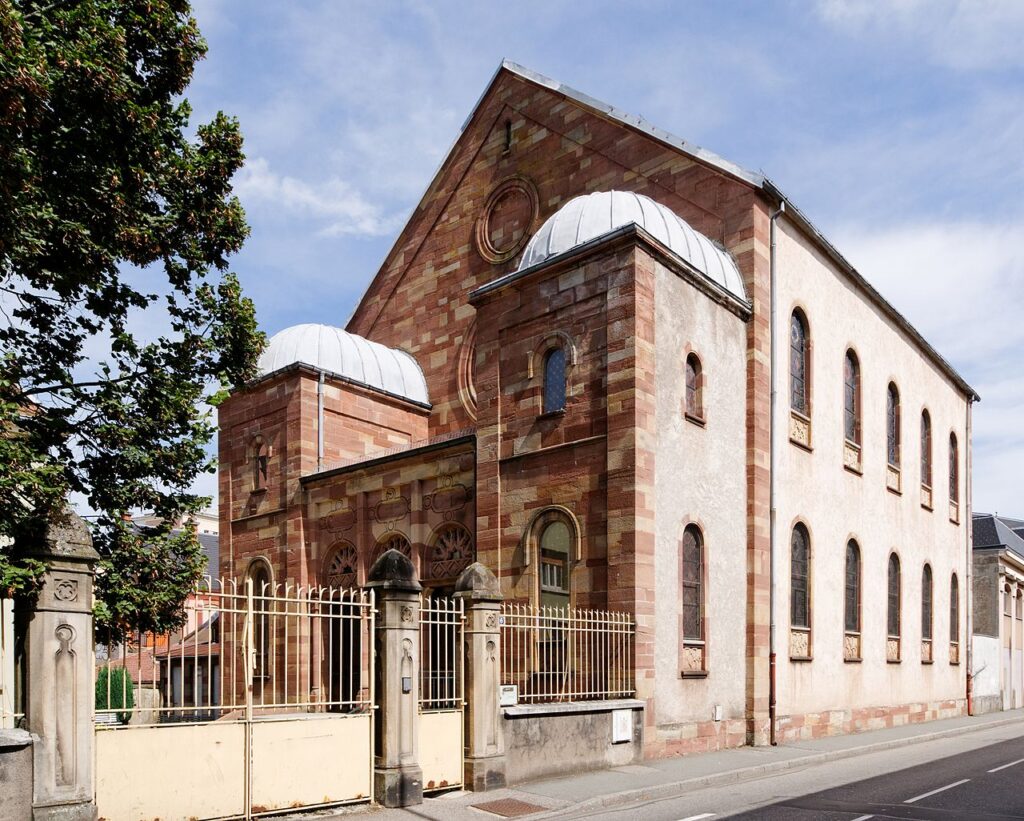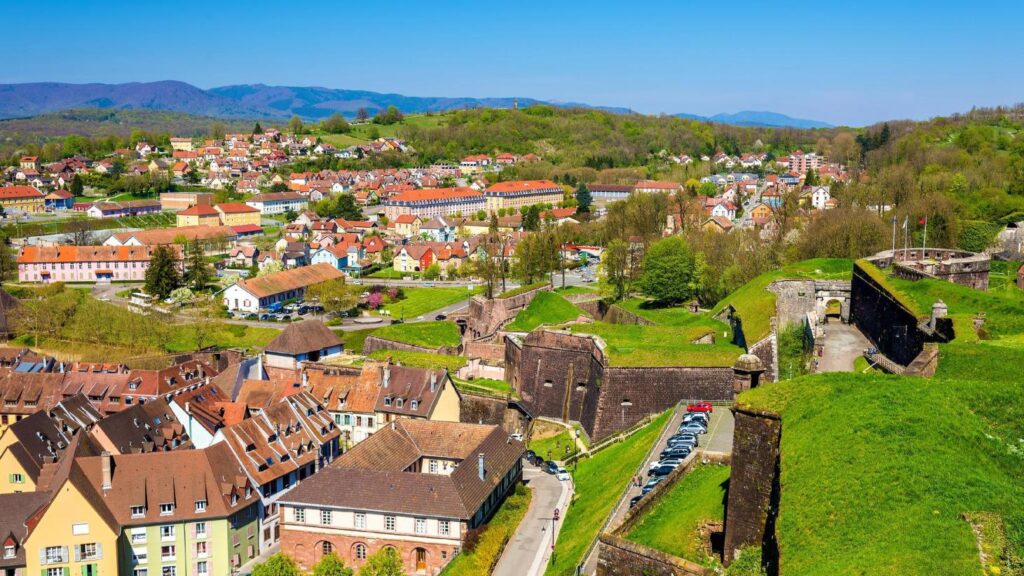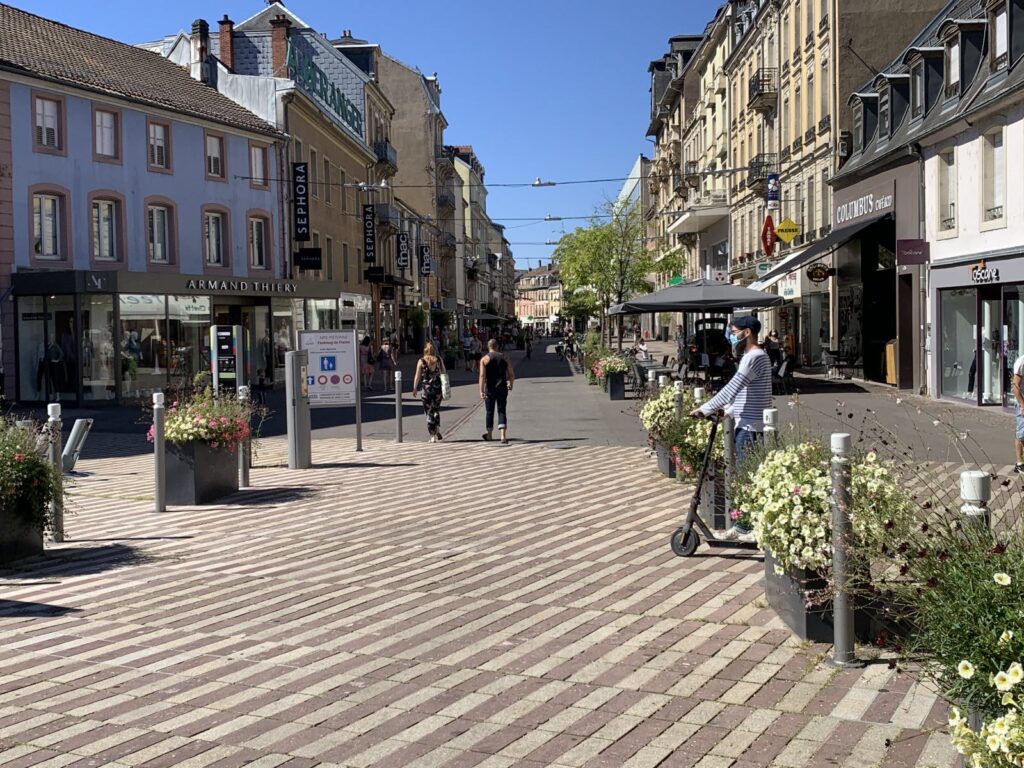Belfort is a city in northeastern France in the Bourgogne-Franche-Comté région, situated between Lyon and Strasbourg and approximately 25 km (16 mi) from the French-Swiss border. It is the biggest town and also the administrative centre of the Territoire de Belfort département.
The residents of the city are called „Belfortains“. The city is located on the Savoureuse river, on a strategically important natural route between the Rhine and the Rhône – the Belfort Gap (Trouée de Belfort) or Burgundian Gate (Porte de Bourgogne).
| Country | France |
|---|---|
| Region | Bourgogne-Franche-Comté |
| Department | Territoire de Belfort |
| Canton | 3 cantons |
| Government | |
| Mayor (2020–2026) | Damien Meslot |
| Area1 | 17.10 km2 (6.60 sq mi) |
| Population (2017-01-01) | 47,656 |
| Time zone | UTC+01:00 (CET) |
| Summer (DST) | UTC+02:00 (CEST) |
History
Belfort’s strategic location, in a natural gap between the Vosges and the Jura, on a route linking the Rhine and the Rhône, has attracted human settlement since Roman times, and has also made it a frequent target for invading armies many times in its history.
The site of Belfort was inhabited in Gallo-Roman times. It was subsequently recorded in the 13th century as a possession of the counts of Montbéliard, who granted it a charter in 1307.
Previously an Austrian possession, Belfort was transferred to France by the Treaty of Westphalia (1648), which ended the Thirty Years‘ War. The town’s fortifications were extended and developed by the military architect Vauban for Louis XIV.
Economy
Belfort is a centre for heavy engineering industries, mostly dedicated to railways and turbines. Belfort is the hometown of Alstom where the first TGVs (Trains à Grande Vitesse, High Speed Trains) were produced, as well as hosting the GE Power European headquarters and a centre of excellence for the manufacturing of gas turbines.
Culture
Eurockéennes
Belfort’s best known cultural event is the annual Eurockéennes, one of France’s largest rock music festivals.
FIMU
Belfort is also well known for hosting the annual Festival International de Musique Universitaire (FIMU)held in May each year. FIMU usually involves over 250 concerts at different locations around the city and around 2500 musicians, most of them students or amateur groups from countries across Europe and the rest of the world. Music styles performed are extremely diverse and include traditional, folk, rock, jazz, classical and experimental.

Sights
- Belfort is the home of the Lion of Belfort, a sculpture (that expressed people’s resistance against the siege in the Franco-Prussian War (1870)) by Frédéric Bartholdi – who shortly afterwards built the Statue of Liberty in New York.
- The Belfort Citadel – A unique example of Vauban pentagonal fortifications
- The Belfort Cathedral, 18th century
- The Belfort Synagogue erected in 1857
- The old town
- The Belfort city museums feature three main areas:
- History (from archeology to military) in the old barracks on the top of the citadel.
- Art (mainly from 16th to 19th century) in the Tour 41
- Modern Art in the Donation Jardot
- Since July 2007, the site of „La Citadelle de la Liberté„, the citadel of Liberty has been open to the public – with a son et lumière animated trail in the moats and its big underground passage.
- From the top of a tall building or going up the nearby mountains on a clear day, the ice-capped mountains of the Alps in Switzerland can be seen.
- Grand souterrain de la citadelle de Belfort- the underground passage of Belfort Citadel.

Natural heritage
The City of Belfort benefits from a natural heritage that is both diverse and remarkable. The natural environments are rich in a variety of flora and fauna.
Ponds
Pond forges
Located about one kilometer from the city centers of Belfort and Offemont, the Etang des Forges occupies a depression between the sandstones of Arsot and the limestones of Miotte. Its origin is a low wetland transformed at the end of the Middle Ages into a body of water, by the creation of a dike, in order to constitute a sufficiently large water reserve for metallurgy.
Bull Pond
This pond of about 4 ha is located in a quiet area in the center of Belfort, along the railway line. It is split in two by a dike. Fishing is regularly practiced south of this dike, the north being classified as a fishing reserve.
Cravanche cave
This cave is incorrectly called Grotte de Cravanche, since it is located in the Municipality of BELFORT. It extends over 290 m long, is divided into nine galleries, three of which are accessible. The largest room is 26 m long, 10 m wide and 10 m high. It has been classified as an artistic site since 1911.
The cave which is currently accessible was discovered by chance in 1876 by two workers. They worked in a quarry located a few meters from the cave. While extracting blocks for the fortifications of Salbert, they shattered a rock, which revealed a narrow opening. The two men discovered numerous bones, pottery and jewelry.

Transport
Road
Like many other European cities, the volume of road traffic in Belfort continues to increases and dominates transport. Belfort is situated at only 25 mi (40 km) from the commercial port of Mulhouse-Rhin which allows international trade. N19 is another major route which joins the south of Belfort with Paris, Nancy and Switzerland.
Air
EuroAirport Basel-Mulhouse-Freiburg is located about 60 km (37 mi) east of Belfort (1 hour drive).
Rail links
Belfort is well connected with the rest of France, with direct connections by train to major destinations such as Paris, Dijon, Besançon, Mulhouse, Strasbourg, Lyon, Marseille, Montpellier and Lille, including high-speed trains. Some trains operate into Switzerland, such as Basel and Zürich stations. There is also a train service to Frankfurt am Main in Germany.
- Gare de Belfort is the main railway station in the centre of the city.
- Gare de Belfort – Montbéliard TGV is the high speed railway station, 9 km (6 mi) south of the city.
Local transport
A local bus network Optymo operates within Belfort (www.optymo.fr). Tickets can be bought from any newsagent in the city, or a bus passenger can send a sms ‚BUS‘ to 84100 and show the confirmation sms as a ticket.
Cycling tracks
The region of Belfort already offers around 70 km (43 mi) of cycling tracks with more under construction. There are many organised cycling events, offering the opportunity for people to explore the area in the company of an official guide.






